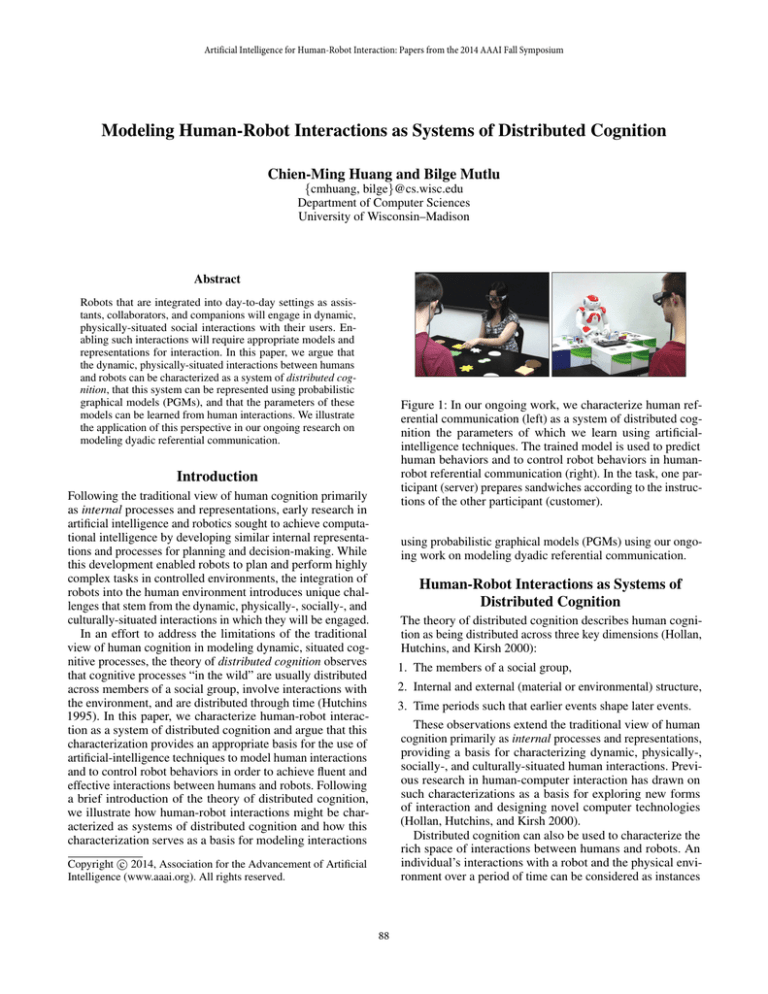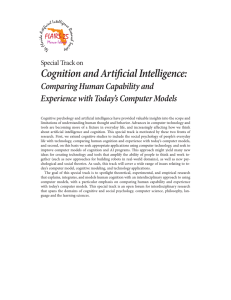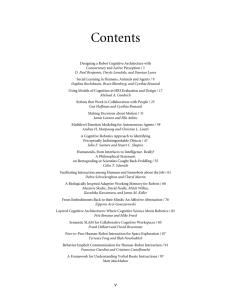Modeling Human-Robot Interactions as Systems of Distributed Cognition {cmhuang,
advertisement

Artificial Intelligence for Human-Robot Interaction: Papers from the 2014 AAAI Fall Symposium
Modeling Human-Robot Interactions as Systems of Distributed Cognition
Chien-Ming Huang and Bilge Mutlu
{cmhuang, bilge}@cs.wisc.edu
Department of Computer Sciences
University of Wisconsin–Madison
Abstract
Robots that are integrated into day-to-day settings as assistants, collaborators, and companions will engage in dynamic,
physically-situated social interactions with their users. Enabling such interactions will require appropriate models and
representations for interaction. In this paper, we argue that
the dynamic, physically-situated interactions between humans
and robots can be characterized as a system of distributed cognition, that this system can be represented using probabilistic
graphical models (PGMs), and that the parameters of these
models can be learned from human interactions. We illustrate
the application of this perspective in our ongoing research on
modeling dyadic referential communication.
Figure 1: In our ongoing work, we characterize human referential communication (left) as a system of distributed cognition the parameters of which we learn using artificialintelligence techniques. The trained model is used to predict
human behaviors and to control robot behaviors in humanrobot referential communication (right). In the task, one participant (server) prepares sandwiches according to the instructions of the other participant (customer).
Introduction
Following the traditional view of human cognition primarily
as internal processes and representations, early research in
artificial intelligence and robotics sought to achieve computational intelligence by developing similar internal representations and processes for planning and decision-making. While
this development enabled robots to plan and perform highly
complex tasks in controlled environments, the integration of
robots into the human environment introduces unique challenges that stem from the dynamic, physically-, socially-, and
culturally-situated interactions in which they will be engaged.
In an effort to address the limitations of the traditional
view of human cognition in modeling dynamic, situated cognitive processes, the theory of distributed cognition observes
that cognitive processes “in the wild” are usually distributed
across members of a social group, involve interactions with
the environment, and are distributed through time (Hutchins
1995). In this paper, we characterize human-robot interaction as a system of distributed cognition and argue that this
characterization provides an appropriate basis for the use of
artificial-intelligence techniques to model human interactions
and to control robot behaviors in order to achieve fluent and
effective interactions between humans and robots. Following
a brief introduction of the theory of distributed cognition,
we illustrate how human-robot interactions might be characterized as systems of distributed cognition and how this
characterization serves as a basis for modeling interactions
using probabilistic graphical models (PGMs) using our ongoing work on modeling dyadic referential communication.
Human-Robot Interactions as Systems of
Distributed Cognition
The theory of distributed cognition describes human cognition as being distributed across three key dimensions (Hollan,
Hutchins, and Kirsh 2000):
1. The members of a social group,
2. Internal and external (material or environmental) structure,
3. Time periods such that earlier events shape later events.
These observations extend the traditional view of human
cognition primarily as internal processes and representations,
providing a basis for characterizing dynamic, physically-,
socially-, and culturally-situated human interactions. Previous research in human-computer interaction has drawn on
such characterizations as a basis for exploring new forms
of interaction and designing novel computer technologies
(Hollan, Hutchins, and Kirsh 2000).
Distributed cognition can also be used to characterize the
rich space of interactions between humans and robots. An
individual’s interactions with a robot and the physical environment over a period of time can be considered as instances
c 2014, Association for the Advancement of Artificial
Copyright Intelligence (www.aaai.org). All rights reserved.
88
To model dyadic referential communication in the
sandwich-making task, we used HMMs to represent the system of distributed cognition and to learn the parameters of this
system (Figure 2). Two separate HMMs were used to model
the relationships between the high-level cognitive states and
the low-level behavioral cues for the two interaction partners.
An additional HMM was used to model how the cognitive
processes of the two partners were interrelated.
Once model parameters are learned from the annotated
data of human interactions, they can be used to control the
behaviors of a robot during its interactions with its user. The
robot can infer its user’s cognitive states based on its observations of its user’s behavioral cues. The inferred user states
can then be used to determine what state the robot should
be in and what behaviors it should display in response to its
user’s state.
Figure 2: We construct three hidden Markov models (HMMs)
to model the distribution of cognitive processes in the
sandwich-making task. The bottom HMMs represent the
relationship between cognitive states and behavioral cues
for the server and the customer. The top HMM captures the
patterns in which the cognitive processes of the two parties
interrelate.
Conclusion
The increasing integration of robots into the human environment introduces new computational and design challenges in representation, recognition, and control in dynamic,
physically- and socially-situated interactions. In this paper,
we argued that the integration of the theory of distributed
cognition from cognitive sciences and representation and
learning techniques from artificial intelligence hold promise
in addressing these challenges. To illustrate this integration,
we presented our ongoing work that uses HMMs to model
human referential communication and to control robot behaviors to achieve fluent human-robot interactions.
of distributed cognition. This characterization in turn can
guide the design of robot systems that achieve more fluent
interactions with their users by integrating their users’ perspectives, knowledge, and perceptions; physical and cultural
contextual factors; and the history of their interactions with
their users and the environment into their planning, decisionmaking, and behaviors.
An Illustrative Example: Dyadic Referential
Communication
Acknowledgments
We thank Sean Andrist and Allison Sauppé for their help
with this work. This work was supported by National Science
Foundation awards 1017952 and 1149970 and the National
Institutes of Health award 1R01HD071089-01A1.
Consider a scenario in which a robot takes orders from and
prepares food for a customer. Fluent interaction between the
robot and its user requires the distribution of a number of
cognitive processes, including exchanging of information,
making references to objects in the environment, and turntaking in communication and performing the task. To model
the cognitive processes involved in this scenario, we recruited
13 pairs of participants to perform in a similar food-serving
task. The task involved one participant making a sandwich
based on instructions from the other participant, as shown
in Figure 1. Participants were instructed to add a total of 15
arbitrary toppings to the sandwich.
Participants performed the task twice, switching roles,
which yielded 26 episodes of interaction. The episodes were
videotaped, and participants’ gaze behaviors were captured
using a dual mobile eye-tracker setup. The data were annotated for high-level cognitive states, such as “thinking which
topping to order,” and for low-level behavioral cues, such
as gaze target and speech referent, in order to model the
relationship between cognitive states and behavioral cues
and the patterns in which the cognitive processes of the two
participants interrelated.
Building on prior work (Huang and Mutlu 2014; Lee et al.
2013; Mead and Mataric 2014), we use PGMs, such as hidden
Markov models (HMMs) and dynamic Bayesian networks
(DBNs), to construct representations of the relationships described above.
References
Hollan, J.; Hutchins, E.; and Kirsh, D. 2000. Distributed
cognition: toward a new foundation for human-computer
interaction research. ACM Transactions on Computer-Human
Interaction (TOCHI) 7(2):174–196.
Huang, C.-M., and Mutlu, B. 2014. Learning-based modeling
of multimodal behaviors for humanlike robots. In Proceedings of the 9th annual ACM/IEEE international conference
on Human-Robot Interaction, 57–64. ACM.
Hutchins, E. 1995. How a cockpit remembers its speeds.
Cognitive science 19(3):265–288.
Lee, J. J.; Knox, W. B.; Wormwood, J. B.; Breazeal, C.; and
DeSteno, D. 2013. Computationally modeling interpersonal
trust. Frontiers in psychology 4.
Mead, R., and Mataric, M. J. 2014. Probabilistic models of
proxemics for spatially situated communication in hri.
89








